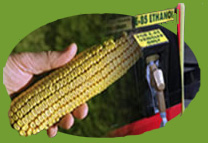|
Also known as ethyl alcohol or grain
alcohol made from corn, Ethanol is a flammable and colorless chemical
compound, which can also be used as a biodegradable fuel additive.
The renewable alternative fuel is an alcohol fuel mixture of 85%
ethanol and 15% gasoline, by volume; Ethanol derived from crops
(bioethanol) is a biofuel. E85 is an alternative fuel blend made
up of 85 percent ethanol and 15 percent gasoline, hence the name “E85”.
E85 is a clean-burning, high-octane fuel, and a versatile solvent
which mixes easily with water and most organic liquids. Most new
cars sold in Brazil, and many newer domestic vehicles are flexible-fuel
vehicles that can run on ethanol, gasoline, or any mixture of the
two. In the United States, current ethanol / gasoline blends are
at a mere 10% ethanol, commonly known as "gasohol" and
is widely sold throughout
the U.S. Midwest, which contains the nation's chief corn-growing
centers.
 The largest single use of ethanol is as a motor fuel and fuel additive with the largest national fuel ethanol industries in Brazil and the United States. The Brazilian ethanol industry is based on sugarcane; as of 2004, Brazil produces 14 billion liters annually, enough to replace about 40% of its gasoline demand. The largest single use of ethanol is as a motor fuel and fuel additive with the largest national fuel ethanol industries in Brazil and the United States. The Brazilian ethanol industry is based on sugarcane; as of 2004, Brazil produces 14 billion liters annually, enough to replace about 40% of its gasoline demand.
The United States fuel ethanol industry is based largely on corn. As of 2005, its capacity is 15 billion liters annually, although the Energy Policy Act of 2005 requires U.S. fuel ethanol production to increase to 7.5 billion gallons (28 billion liters) by 2012.
In 2005, the Indy Racing League announced its cars will run on a 10% ethanol - 90% methanol blend fuel, and starting in 2007, the cars will race on 100% ethanol.
Thailand, India, China and Japan have all launched national gasohol policies to reduce consumption of fossil fuels. Thailand started blending 10% ethanol for its ULG95 in 1985, and now has more than 4000 stations serving E10. The blending of 10% ethanol into gasoline will be mandated by the end of 2006 along with the import ban on MTBE. Methyl tert-butyl ether (MTBE) is a flammable liquid which is used as an additive in unleaded gasoline. It is expected that once the production of ethanol from cassava and sugar cane molasses can be ramped up, a higher blending ratio like E20 or E85 and Flexible Fuel Vehicles will be introduced to Thailand.
Ethanol with a water content of 2% or less can be used as the alcohol in the production of biodiesel, replacing methanol, which is quite dangerous to work withThe Clean Air Act Amendments of 1990 mandated the sale of oxygenated fuels in areas with unhealthy levels of carbon monoxide. Since that time, there has been strong demand for ethanol as an oxygenate blended with gasoline. In the United States each year, approximately 2 billion gallons are added to gasoline to increase octane and improve the emissions quality of gasoline.
Cellulosic ethanol is a blend of normal ethanol that can be produced from a great diversity of biomass including waste from urban, agricultural, and forestry sources. There are at least two methods of production of cellulosic ethanol-enzymatic hydrolysis and synthesis gas fermentation. Neither process generates toxic emissions when it produces ethanol. The technology is very new and exists in pilot configurations where testing is ongoing.
According to US Department of Energy studies conducted by the Argonne Laboratories of the University of Chicago, one of the benefits of cellulosic ethanol is that it reduces greenhouse gas emissions (GHG) by 85% over reformulated gasoline. By contrast, sugar-fermented ethanol reduces GHG emissions by 18% to 29% over gasoline.
|







